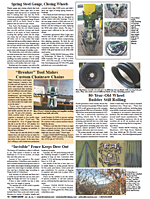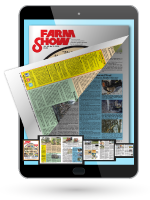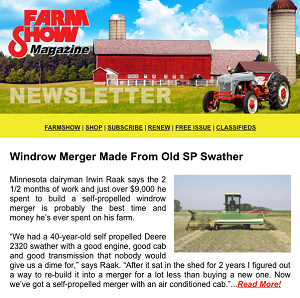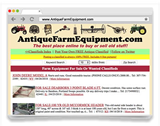Double-Knife Stubble Cutter
Farmers who cut off only the heads on small grain crops can go faster and use less fuel while at the same time doing a better threshing job. The problem is, how do you handle the tall straw? Ken Blosser says his "double-knife" stubble cutter may be the answer.
The 46-ft. wide, pto-driven rig is equipped with two belt-driven sicklebars, one 8 in. higher than the other. The ma-chine allows Blosser set his grain head 24 in. high as he combines. He later uses his stubble cutter to cut the standing straw, running the bottom cutterbar about 8 in. off the ground. The 8-in. long stems easily work through his tillage equipment.
"Reducing the amount of straw going through the combine allows incredible in-creases in harvest efficiency," says Blosser. "Studies show that by cutting 20 in. off the ground instead of 8 in., you can gain 85% in harvest efficiency. In barley you can gain 37%. It gives you the benefits of a stripper header, which is designed to put less straw through the combine.
"The double cutterbar works better than using a flail chopper or rotary mower be-cause it requires less horsepower and works much faster. My 46-ft. model requires only a 60 to 70 hp tractor compared to a 150 hp tractor required by flail or rotary mowers. I can cover 35 to 40 acres per hour compared to about 15 acres per hour for flail or rotary mowers.
"Another advantage is near-perfect distribution of straw over the entire width of the machine. Works great for no-till be-cause there's no heavy mulch on the ground to retard soil warm-up in the spring. It works better than combine choppers which don't always spread straw evenly. Mowers can leave heavy strips of residue after cutting. On some of my fields I leave the 24-in. high stubble standing over the winter - it makes a perfect snow catch that evenly distributes the snow across the field. I use my double knife cutter the following spring.
"It also reduces stress on the combine operator because you don't have to worry about picking up rocks or damaging guards or sickles."
The stubble cutter's two sicklebars are belt-driven off the pto by a reciprocating knife drive system that works off a jackshaft mounted at the center. A pulley is used to drive a counterweight eccentric that's connected to a weighted shaft. When the shaft rotates clockwise, the bottom sicklebar goes left and the top sicklebar goes right, and vise versa. The top sicklebar is mounted 8 in. ahead of the bottom sicklebar so that the bottom part of the stem is free to fly upward as it's cut. The rig's four wheels are hydraulically raised or lowered.
"I go counterclockwise around the field - opposite the direction of my combine - so that bent-over straw in the combine wheel tracks is easier to cut," notes Blosser.
He has negotiated a licensing agreement with an implement manufacturer and expects to have models for sale in time for this year's harvest. A 42-ft. model will sell for about $15,000 to $16,000 (Canadian).
Contact: FARM SHOW Followup, Ken Blosser, Box 743, Kelvington, Sask., Canada S0A 1W0 (ph 306 327-4832).

Click here to download page story appeared in.
Click here to read entire issue
Double-Knife Stubble Cutter CROPS Straw 19-2-24 Farmers who cut off only the heads on small grain crops can go faster and use less fuel while at the same time doing a better threshing job. The problem is, how do you handle the tall straw? Ken Blosser says his "double-knife" stubble cutter may be the answer.
The 46-ft. wide, pto-driven rig is equipped with two belt-driven sicklebars, one 8 in. higher than the other. The ma-chine allows Blosser set his grain head 24 in. high as he combines. He later uses his stubble cutter to cut the standing straw, running the bottom cutterbar about 8 in. off the ground. The 8-in. long stems easily work through his tillage equipment.
"Reducing the amount of straw going through the combine allows incredible in-creases in harvest efficiency," says Blosser. "Studies show that by cutting 20 in. off the ground instead of 8 in., you can gain 85% in harvest efficiency. In barley you can gain 37%. It gives you the benefits of a stripper header, which is designed to put less straw through the combine.
"The double cutterbar works better than using a flail chopper or rotary mower be-cause it requires less horsepower and works much faster. My 46-ft. model requires only a 60 to 70 hp tractor compared to a 150 hp tractor required by flail or rotary mowers. I can cover 35 to 40 acres per hour compared to about 15 acres per hour for flail or rotary mowers.
"Another advantage is near-perfect distribution of straw over the entire width of the machine. Works great for no-till be-cause there's no heavy mulch on the ground to retard soil warm-up in the spring. It works better than combine choppers which don't always spread straw evenly. Mowers can leave heavy strips of residue after cutting. On some of my fields I leave the 24-in. high stubble standing over the winter - it makes a perfect snow catch that evenly distributes the snow across the field. I use my double knife cutter the following spring.
"It also reduces stress on the combine operator because you don't have to worry about picking up rocks or damaging guards or sickles."
The stubble cutter's two sicklebars are belt-driven off the pto by a reciprocating knife drive system that works off a jackshaft mounted at the center. A pulley is used to drive a counterweight eccentric that's connected to a weighted shaft. When the shaft rotates clockwise, the bottom sicklebar goes left and the top sicklebar goes right, and vise versa. The top sicklebar is mounted 8 in. ahead of the bottom sicklebar so that the bottom part of the stem is free to fly upward as it's cut. The rig's four wheels are hydraulically raised or lowered.
"I go counterclockwise around the field - opposite the direction of my combine - so that bent-over straw in the combine wheel tracks is easier to cut," notes Blosser.
He has negotiated a licensing agreement with an implement manufacturer and expects to have models for sale in time for this year's harvest. A 42-ft. model will sell for about $15,000 to $16,000 (Canadian).
Contact: FARM SHOW Followup, Ken Blosser, Box 743, Kelvington, Sask., Canada SOA IWO (ph 306 327-4832).
To read the rest of this story, download this issue below or click
here to register with your account number.








